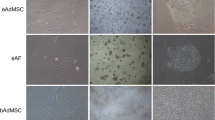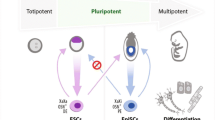Abstract
Groundbreaking work by Takahashi and Yamanaka in 2006 demonstrated that non-embryonic cells can be reprogrammed into pluripotent stem cells (PSCs) by forcing the expression of a defined set of transcription factors in culture, thus overcoming ethical concerns linked to embryonic stem cells. Induced PSCs have since revolutionized biomedical research, holding tremendous potential also in other areas such as livestock production and wildlife conservation. iPSCs exhibit broad accessibility, having been derived from a multitude of cell types and species. Apart from humans, iPSCs hold particular medical promise in the horse. The potential of iPSCs has been shown in a variety of biomedical contexts in the horse. However, progress in generating therapeutically useful equine iPSCs has lagged behind that reported in humans, with the generation of footprint-free iPSCs using non-integrative reprogramming approaches having proven particularly challenging. A greater understanding of the underlying molecular pathways and essential factors required for the generation and maintenance of equine iPSCs and their differentiation into relevant lineages will be critical for realizing their significant potential in veterinary regenerative medicine. This article outlines up-to-date protocols for the successful culture of equine iPSC, including colony selection, expansion, and adaptation to feeder-free conditions.
Access this chapter
Tax calculation will be finalised at checkout
Purchases are for personal use only
Similar content being viewed by others
References
Shi Y, Inoue H, Wu JC, Yamanaka S (2017) Induced pluripotent stem cell technology: a decade of progress. Nat Rev Drug Discov 16(2). https://doi.org/10.1038/nrd.2016.245
Katayama M, Fukuda T, Kaneko T et al (2022) Induced pluripotent stem cells of endangered avian species. Commun Biol 5(1). https://doi.org/10.1038/s42003-022-03964-y
Takahashi K, Yamanaka S (2006) Induction of pluripotent stem cells from mouse embryonic and adult fibroblast cultures by defined factors. Cell 126(4). https://doi.org/10.1016/j.cell.2006.07.024
Steinle H, Weber M, Behring A et al (2019) Reprogramming of urine-derived renal epithelial cells into iPSCs using srRNA and consecutive differentiation into beating cardiomyocytes. Mol Ther Nucleic Acids:17. https://doi.org/10.1016/j.omtn.2019.07.016
Donadeu FX, Esteves CL (2015) Prospects and challenges of induced pluripotent stem cells in equine health. Front Vet Sci 2:59. https://doi.org/10.3389/fvets.2015.00059
Ban H, Nishishita N, Fusaki N et al (2011) Efficient generation of transgene-free human induced pluripotent stem cells (iPSCs) by temperature-sensitive Sendai virus vectors. Proc Natl Acad Sci U S A 108(34). https://doi.org/10.1073/pnas.1103509108
Okita K, Matsumura Y, Sato Y et al (2011) A more efficient method to generate integration-free human iPS cells. Nat Methods 8(5). https://doi.org/10.1038/nmeth.1591
Anokye-Danso F, Trivedi CM, Juhr D et al (2011) Highly efficient miRNA-mediated reprogramming of mouse and human somatic cells to pluripotency. Cell Stem Cell 8(4). https://doi.org/10.1016/j.stem.2011.03.001
Nagy K, Sung HK, Zhang P et al (2011) Induced pluripotent stem cell lines derived from equine fibroblasts. Stem Cell Rev Rep 7(3). https://doi.org/10.1007/s12015-011-9239-5
Yu L, Wei Y, Sun HX et al (2021) Derivation of intermediate pluripotent stem cells amenable to primordial germ cell specification. Cell Stem Cell 28(3). https://doi.org/10.1016/j.stem.2020.11.003
Chen G, Gulbranson DR, Hou Z et al (2011) Chemically defined conditions for human iPSC derivation and culture. Nat Methods 8(5). https://doi.org/10.1038/nmeth.1593
Wiley LA, Burnight ER, Deluca AP et al (2016) CGMP production of patient-specific iPSCs and photoreceptor precursor cells to treat retinal degenerative blindness. Sci Rep:6. https://doi.org/10.1038/srep30742
Sharma R, Livesey MR, Wyllie DJA et al (2014) Generation of functional neurons from feeder-free, keratinocyte-derived equine induced pluripotent stem cells. Stem Cells Dev 23(13). https://doi.org/10.1089/scd.2013.0565
Quattrocelli M, Giacomazzi G, Broeckx SY et al (2016) Equine-induced pluripotent stem cells retain lineage commitment toward myogenic and chondrogenic fates. Stem Cell Rep 6(1). https://doi.org/10.1016/j.stemcr.2015.12.005
Conner DA (2001) Mouse embryo fibroblast (MEF) feeder cell preparation. Curr Protoc Mol Biol 51:23. https://doi.org/10.1002/0471142727.mb2302s51
Rodin S, Antonsson L, Hovatta O, Tryggvason K (2014) Monolayer culturing and cloning of human pluripotent stem cells on laminin-521-based matrices under xeno-free and chemically defined conditions. Nat Protoc 9(10). https://doi.org/10.1038/nprot.2014.159
Braam SR, Zeinstra L, Litjens S et al (2008) Recombinant Vitronectin is a functionally defined substrate that supports human embryonic stem cell self-renewal via αVβ5 integrin. Stem Cells 26(9). https://doi.org/10.1634/stemcells.2008-0291
Chen G, Gulbranson DR, Hou Z et al (2011) Chemically defined conditions for human iPSC derivation and culture. Nat Methods 8(5):424–429
Castro-Viñuelas R, Sanjurjo-Rodríguez C, Piñeiro-Ramil M et al (2021) Tips and tricks for successfully culturing and adapting human induced pluripotent stem cells. Mol Ther Methods Clin Dev:23. https://doi.org/10.1016/j.omtm.2021.10.013
Acknowledgments
JF holds a PhD studentship funded through an industrial contract with IC BIOSOLUTIONS. The Roslin Institutes receives funding from the Biotechnology and Biological Sciences Research Council through an institute strategic program grant.
Author information
Authors and Affiliations
Corresponding author
Editor information
Editors and Affiliations
Rights and permissions
Copyright information
© 2024 The Author(s), under exclusive license to Springer Science+Business Media, LLC, part of Springer Nature
About this protocol
Cite this protocol
Falk, J., Donadeu, F.X. (2024). Equine Induced Pluripotent Stem Cell Culture. In: Baratta, M. (eds) Epithelial Cell Culture. Methods in Molecular Biology, vol 2749. Humana, New York, NY. https://doi.org/10.1007/978-1-0716-3609-1_16
Download citation
DOI: https://doi.org/10.1007/978-1-0716-3609-1_16
Published:
Publisher Name: Humana, New York, NY
Print ISBN: 978-1-0716-3608-4
Online ISBN: 978-1-0716-3609-1
eBook Packages: Springer Protocols




